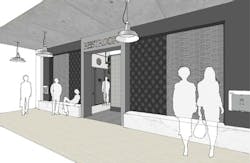Announcing the Winner of Sloan’s Design Challenge
Lida Lewis, a passionate designer and educator from Arlington, Virginia, is the official winner of the Restroom of the Future Challenge. Sponsored by Sloan, the design contest had competitors reimagine a commonly used and rarely designed space – the commercial public restroom.
“The public restroom is an ever-evolving environment, one that is at the forefront of innovation as commercial buildings look toward the future,” said Sloan Chief Sales and Marketing Officer Parthiv Amin. “That’s why Sloan is so proud to sponsor the Restroom of the Future contest, as entrants submit exciting new designs that aim to take the restroom forward for decades to come.”
Using a variety of Sloan products, Lewis’s futuristic restroom configuration is a gender-neutral design that also takes a variety of health and welfare concerns into consideration as well.Products:
- Water Closet: Sloan Elongated Wall Mounted WC - ST-2459
- Flushometer: Sloan Royal Reclaimed Water Flushometer - Royal 186-0.125 RW
- Health Spray: Sloan’s Health Faucet and Angle Valve
- Faucet: Sloan Optima Solar Sensor Faucet - EAF-275-SOL-CP-0.35GPM-MLM-IR-IQ-FCT
- Soap Dispenser: Sloan Soap Dispenser - ESD-500-CP
- Sink: SloanStone® 1-Station Wall-Mounted Arrowhead Sink - ELA-81000
“I loved this,” said Lewis of Sloan’s challenge. “It was so well done. [There was] just enough information (client bio, floorplan), and just enough constraints (one product, limited adjustment of the plan) to allow enough leeway for creativity, but small enough in scope to think deeply about the subject. And [it was] open to professionals, not just students – that’s wonderful, as so many are not. I wish more manufacturers would provide more opportunities for this kind of work!”
Check out this winning design by Lida Lewis:
Code Compliance
The layout of all fixtures, fittings, and accessories within the facility are fully compliant with the provisions of the current accessibility codes. In addition, the design accommodates several additional health, safety, and welfare concerns of the occupants.
Physical limitations
All stalls are sized to accommodate ambulatory access, and are provided with horizontal (and vertical, where appropriate) grab bars to maximize access. Stall latch hardware is operable without the use of pinching, turning, or grasping of the latch.
Physical access to the restroom facility is also enhanced by the provision of a simple open doorway, rather than a typical latched door.
Visual Limitations
Accessibility for visually limited occupants is enhanced with the provision of a very high contrast finish design. The use of a deep charcoal and soft white palette is both accommodating of future facility or university brand changes and the needs of lower sighted individuals.
Texture is also used to increase accessibility for these occupants, as different floor textures are provided in stalls, the circulation area, and the sink area to signal for those using canes to assist in mobility of the different restroom zones.
Lighting Quality
High CRI (color rendering index) lighting is provided within the space for many considerations, among them health. High color rendering index lighting allows for occupants in the facility to better assess their health by increasing the occupant’s ability to identify irregularities in skin and waste coloration, and therefore is anticipated to increase preventative care measures and increase population health.
Water Quality
This ensures that, regardless of any compromises of the municipal water infrastructure system or building plumbing, the water reaching occupants for consumption is of reliably high caliber.
Air Quality
Olfactory comfort is ensured through the provision of mechanical exhaust fans within each individual restroom stall. Additionally, the fresh air supply is filtered with MERV 13 and carbon filters for a variety of contaminants. Finally, the provision of heating and cooling through a radiant system decoupled from the air supply ensures minimal disbursement of contaminants.
Cultural Accommodation
Many students and faculty of, and visitors to, the university are from a wide variety of cultural backgrounds. To better accommodate their cultural needs in restroom use, health sprays, and two stalls with Eastern (in addition to the other Western) style toilets are provided for use.
Safety
Safety for all occupants of the university is enhanced by the open, non-binary restroom facility design. All necessary activities are accommodated in single, isolated stalls. This isolation is also mitigated through a number of design features.
For occupants within the stalls, a pane of high opacity glass is provided at the shelf in the rear of each stall. This, coupled with the provision of occupancy sensor controlled wall mounted lighting and exhaust fan at the rear of each stall, provides a visual and an audial signal when adjacent stalls are in use.
Shielded peep holes are also provided at stall doors to enable occupants of the restroom stall to assess the exterior sink and circulation area before exiting the stall, if desired.
Cleanliness/Hygiene
The flooring and rear fixture wall surface in the stalls, and the low partition surrounding the sinks, consist of large (~3m x 10m) sheets of porcelain tile panels. These slip coefficient compliant panels minimize grout lines for maximum cleanliness and ease of maintenance.
The provision of paper towels for hand drying minimizes the spread of infectious materials. They are provided individually at each sink station, as well as a trash receptacle and soap dispenser, to minimize the occurrence of dripped water or soap, or abandoned towels from hand washing.
High Traffic
The reconfiguration of the existing restroom footprint into a non-gender-binary single facility greatly increases the fixture count and capacity of the facility. Additionally, the provision of fully unisex restrooms assures speedy access to the necessary facilities for those of any identity at all times. The inclusion of accessible features in all stalls additionally minimizes the possibility that those of different abilities are not required to wait for fixture access.
Water bottle filling stations are provided outside of the facility, adjacent to porcelain tile clad benches for occupants waiting for others to exit the facility. These waiting stations additionally discourage loitering in the restroom space, maximizing restroom circulation flow. These stations are provided distally from the restroom entry point (while still in line with wet stack locations) to separate restroom use traffic from that of occupants seeking to hydrate.
Need for Privacy
Visually, privacy is provided with full height stall walls, which have only a small gap under the stall door (roughly 2”) to accommodate potential flooding concerns. Stall doors open to the rear wall of the facility, outside of sight of all entries and mirrored surfaces. All stall walls are designed for minimum sight line gaps, with full height hinges and latch jamb overlays. Mirrored surfaces are oriented to provide the minimum of additional view angles.
Acoustic privacy is also accommodated to the greatest practical intent by the full height stalls. The reclaimed water feature, with water continually cascading down a glass surface at the center of the facility (between the two sink banks) additionally improves audial comfort. The sound of the water feature provides a masking sound element to minimize sound disruption.
Water Conservation and Waste Reduction
Excess system greywater, when present, is used for the wicking irrigation system in this restroom and at other indoor and exterior planting locations at the facility.
Energy Savings
The primary energy draws within the restroom facility are in HVAC and lighting use. For lighting, sensors are used extensively in the facility to reduce energy use to only that required by Individual restroom occupants.
Narrow-visual-band sensors are mounted on the underside of the planting shelf to ensure the circuit controlling the overhead sconce is only activated when there is a user at each sink station.
Similarly, the lighting and the individual exhaust fan within each restroom stall activates only when an occupant is present.
While the overhead general ambient lighting system is operable at 0.4 Watts/SF from 8am to 8pm, it is also linked to a time clock and occupant sensor system. Outside of primary hours, the time clock overrides the ambient lighting to emergency capacity only. Only when an occupant enters the portal of the facility and activates the doorway sensor is this ambient system overridden to occupied settings.
Heating and cooling of the space is controlled through a system decoupled from the fresh air supply. Instead, heating and cooling is accomplished with embedded radiant systems in the restroom floor.
As the winner, Lewis receives an all-expenses-paid trip to Design Connections from October 7-10, 2018 at Hyatt Lost Pines Resort and Spa in Austin, Texas. Additionally, Lewis can look forward to spa treatments valued at $500 at the Hyatt Lost Pines.
Here’s another design innovator: I Hear Design Episode 4: Chris Rutherford is Salvaging Architecture
About the Author

Adrian Schley
Associate Editor
Adrian Schley was an Associate Editor for i+s, where she covered the commercial interior design industry since 2018. Her work can also be found in BUILDINGS and Meetings Today.
